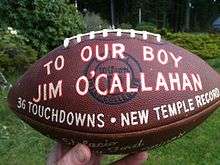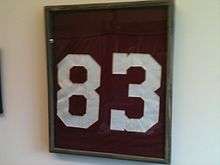Jim Callahan (American football)


Jim Callahan (born July 29, 1946 in Philadelphia, Pennsylvania[1]) was an American football player and author who currently resides in Anna Maria, Florida. Callahan was selected in the 8th round of the 1969 NFL Draft by the Atlanta Falcons;[2] 185 picks after O.J. Simpson, the first player selected that year.[3] Callahan was recruited out of college by future NFL general manager Bobby Beathard and signed a contract with the Falcons one month later.[4]
Callahan played wide receiver at Temple University for the 1966, 1967, and 1968 football seasons under head coach George Makris.[5] Prior to enrollment at Temple University, Callahan earned first team All-Catholic League honors at Cardinal Dougherty High School.[6] Callahan scored a touchdown the first 10 times he touched the football in intercollegiate play, leading the New York Times to report facetiously that "Jim Callahan of Temple is in a slump" after the 11th reception of his career did not go for a touchdown.[7]
Callahan holds many pre-1971 era Temple Owls football records. These include most career points (218 points), most points in a season (86 points in 1968), most points in a game (30 points verses Bucknell University in 1966), most career touchdowns (36 touchdowns), most touchdowns in a season (14 touchdowns in 1968), most career receptions (105 receptions), most receptions in a season (57 receptions in 1968), most career receiving yards (1,848 yards), most receiving yards in a season (786 yards in 1968), and most career receiving touchdowns (36 touchdowns).[8]
Callahan also was on the receiving end of the longest pass play in Temple history; a 90-yard pass thrown by quarterback John Waller against Northeastern University in 1968.[8] His five touchdown receptions against Bucknell in 1966, the most touchdown receptions for one game in Temple history, helped the Temple Owls defeat the Bucknell Bison for the first time in 12 years.[9]
After college, Callahan spent the 1969 season with the Alabama Hawks of the Continental Football League; a farm team located in Huntsville, Alabama.[10] He was inducted into the Temple University Hall of Fame in 1981.[11]
Callahan authored the book WALLS in 1993 (with a revised edition in 1996). According to Callahan, WALLS is "based on the belief that life is not a series of unrelated random events. There is a process to how people gather and evaluate information and make the choices that direct their life. WALLS offers an opportunity for you to step out of your daily routine and explore some issues that have a tremendous impact on how you direct your life toward the outcome you desire."[1]

References
- 1 2 Callahan, Jim (1996). WALLS. Anna Maria, FL: Callahan Associates. ISBN 0963627015.
- ↑ "Steelers and Eagles Draft Grid Talent". Gettysburg Times. January 30, 1969. Retrieved 12 April 2013.
- ↑ "Pro Football Reference". Pro Football Reference. Retrieved 12 April 2013.
- ↑ "Falcons Sign Six". The Tuscaloosa News. February 21, 1969. Retrieved 12 April 2013.
- ↑ Temple University (2012). 2012 Temple Football Media Guide. Philadelphia, PA: Temple University. p. 181.
- ↑ "Owl Sports". Retrieved 12 April 2013.
- ↑ Gordon, Jr., White (October 27, 1966). "Temple's Star Second-Stringers Give Rivals First-Class Worry". New York Times. Retrieved 12 April 2013.
- 1 2 Temple University (2012). 2012 Temple Football Media Guide. Philadelphia, PA: Temple University. p. 206.
- ↑ "Temple Finally Beats Bucknell-And How!!". Reading Eagle. October 8, 1966. Retrieved 12 April 2013.
- ↑ "Booster Club of the Continental Football League". Booster Club of the Continental Football League. Retrieved 12 April 2013.
- ↑ "Owl Sports". Owl Sports. Retrieved 12 April 2013.
External links
- http://www.amazon.com/Walls-James-J-Jr-Callahan/dp/0963627015
- http://owlsports.com/hof.aspx?hof=234&path=&kiosk=